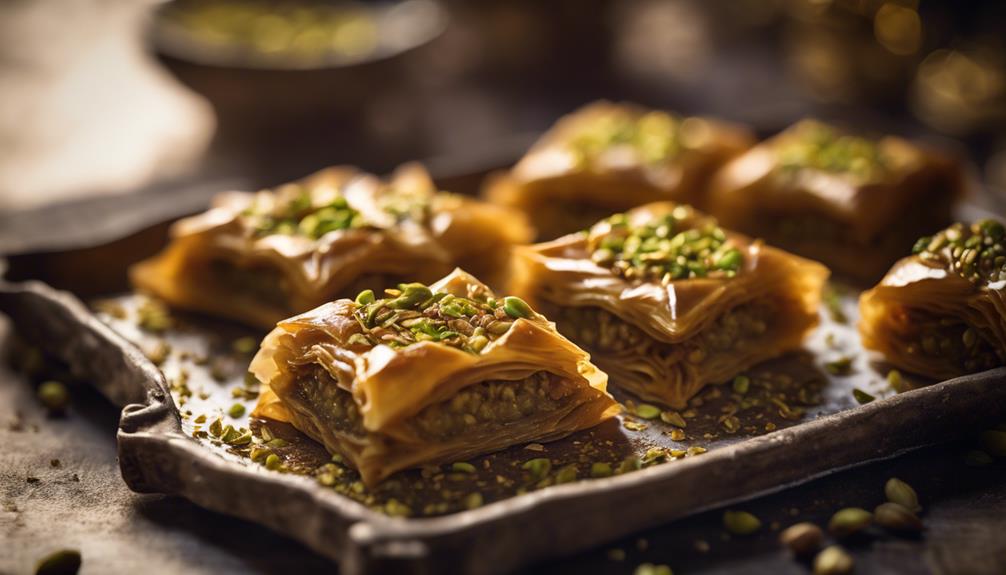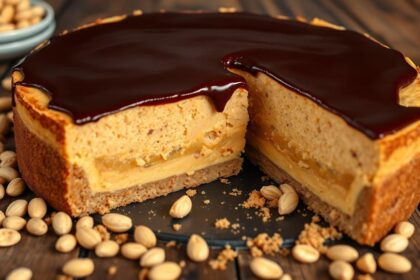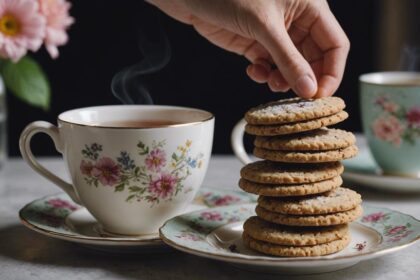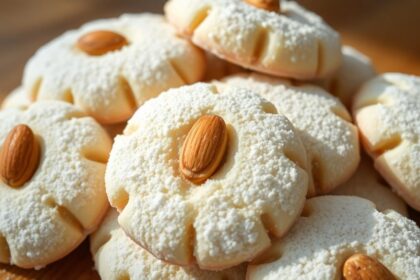Unravel the layers of baklava to experience a fusion of crispy phyllo dough, rich nut fillings, and sweet honey syrup in this Middle Eastern delight. Each bite is a symphony of flavors, blending textures and sweetness into a divine treat. Want to discover more about the origins, ingredients, and techniques that create this exquisite dessert?
The Origin of Baklava
Explore the ancient roots of baklava, tracing its origins back to the Byzantine Empire. The dessert's history is a tapestry woven with stories within its delicate layers. As baklava journeyed across the Middle East and Mediterranean, it absorbed different cultural influences, shaping its evolution into the beloved treat we're familiar with today. Each layer of baklava represents a chapter in its rich historical narrative, reflecting the diverse mosaic of flavors that characterize this indulgent dessert.
Throughout history, various cultures have added their unique twists to the recipe, contributing to the intricate layers of flavors and textures found in baklava. From the flaky phyllo dough to the sweet honey and nut filling, each layer plays an essential role in creating the harmonious symphony of tastes that define this Middle Eastern delight. By understanding the origins of baklava and the significance of its layers, one can truly appreciate the cultural heritage and culinary artistry behind this iconic dessert.
Essential Ingredients for Baklava
When preparing baklava, you'll need a few essential ingredients to capture the traditional flavors and textures that define this Middle Eastern dessert. The first key component is phyllo dough, a thin and delicate pastry that bakes into crispy layers, providing the perfect contrast to the rich filling. Nuts, such as walnuts, pistachios, or almonds, are also vital, offering a nutty and crunchy texture that complements the flakiness of the phyllo dough.
Butter plays a significant role in baklava, as it's generously brushed between the layers of phyllo dough. This addition creates a buttery and decadent pastry that melts in your mouth with each bite. Finally, the sweet syrup, typically made with honey, sugar, water, and a hint of lemon juice, is poured over the baked baklava, adding a glossy finish and the perfect amount of sweetness to balance the flavors.
These essential ingredients work together harmoniously to create the beloved treat that's baklava, a dessert cherished in Middle Eastern cuisine for its intricate layers and delightful flavors.
Layering the Filo Dough

To master the art of crafting authentic baklava, you must skillfully layer the delicate filo dough, making sure each sheet is brushed with melted butter for that perfect balance of richness and crispiness. Filo dough, also known as phyllo dough, is a paper-thin pastry that plays an important role in creating the flaky pastry texture of baklava.
The thin layers of filo dough are what give baklava its signature delicate and flaky mouthfeel. Brushing each sheet with melted butter not only adds richness but also helps achieve that desirable crispiness when baked. Layering the filo dough requires precision and patience to make sure that each layer contributes to the overall texture and flavor of the final dessert.
This meticulous process of layering the filo dough is essential in capturing the essence of baklava, creating a harmonious blend of textures that make this Middle Eastern delight truly irresistible.
Nutty Fillings and Variations
In baklava, the nutty fillings, such as walnuts, pistachios, or almonds, play an essential role in creating its rich and flavorful profile. The nut mixture in baklava provides a crunchy texture and a distinct nuttiness that complements the sweet syrup-soaked layers of filo dough perfectly.
Here are some variations and details about nut fillings in baklava:
- Some baklava recipes feature a mix of walnuts, pistachios, and almonds to offer a diverse and complex taste experience.
- Pistachios not only add a vibrant green color to baklava but also contribute a unique sweetness that sets this dessert apart.
- The nut filling in baklava is often seasoned with spices like cinnamon and cloves, enhancing the overall flavor and aroma of this Middle Eastern delicacy.
These variations in nut choices and combinations showcase the versatility of baklava while maintaining its signature nutty essence.
Perfecting the Baklava Syrup

When perfecting the baklava syrup, guarantee the consistency by boiling it to the right thickness.
Infuse the syrup with flavors like cinnamon or rose water for a unique taste.
Master different application methods to evenly distribute the syrup over the baklava layers.
Syrup Consistency Tips
Make sure that your baklava syrup reaches a consistency where it coats the back of a spoon without dripping off. Achieving the right thickness is crucial to make sure it permeates the layers of phyllo dough evenly.
Here are some tips to help you perfect your baklava syrup:
- Balancing Act: Find the perfect blend of sugar, honey, water, and lemon juice to achieve the ideal sweetness and tanginess.
- Timing is Key: Pour the syrup over the hot baklava fresh out of the oven for best absorption and flavor infusion.
- Texture Test: Ensure the syrup coats the back of a spoon smoothly without running off, striking the right balance between too thin and too thick.
Flavor Infusion Techniques
To enhance the flavor of your baklava, consider experimenting with different aromatic spices and extracts to elevate the richness of the syrup infusion.
By using flavor infusion techniques, you can add depth and complexity to the traditional syrup mixture of honey, sugar, water, and lemon juice.
Try incorporating cinnamon, cloves, cardamom, or even a hint of rose water to create a unique and enticing flavor profile.
These extra ingredients can bring warmth, floral notes, or a spicy kick to your baklava, making each bite a delightful surprise.
Adjust the quantities of these additions according to your taste preferences, ensuring a harmonious blend of flavors that perfectly complement the nutty and buttery layers of your baklava.
Syrup Application Methods
Consider carefully drizzling the warm syrup over the freshly baked baklava to guarantee a thorough and even distribution of sweetness and moisture throughout the layers. To perfect the sweet syrup application, follow these tips:
- Ensure Pouring: Make sure the syrup is evenly poured over the entire surface of the baklava for consistent flavor.
- Slow Drizzling: Slowly drizzle the sweet syrup over the baklava to allow it to seep into all the layers effectively.
- Cooling Period: Allow the baklava to cool completely after adding the syrup to let it absorb the sweet liquid fully.
Mastering the art of sweet syrup application is key to achieving the delectable and sticky texture that defines authentic baklava.
Baking and Golden Crispness

To achieve that perfect golden crispness in your baklava, make sure each phyllo dough layer is generously brushed with melted butter before baking at 350°F for around 50 minutes. Baking until golden ensures that the phyllo dough layers become flaky and crunchy, creating a satisfying texture that melds the nuts and spices together.
As the baklava bakes, the aroma of the nuts and spices fills your kitchen, signaling that it's almost time for the final syrup drenching. The baking process is vital in achieving the desired texture and flavor of baklava. The golden exterior not only adds visual appeal but also indicates that the layers have crisped up to perfection.
With each minute in the oven, the baklava transforms, turning into a delectable treat that balances sweetness, crunch, and nuttiness. Paying attention to the baking time and making sure that each layer is properly buttered are key steps in creating a baklava that delights with every bite.
Serving and Presentation Tips
When serving baklava, remember to use a sharp knife for clean cuts and enhance its presentation by using a decorative platter.
Garnish your baklava with chopped nuts or powdered sugar to add an elegant touch.
Serve this delightful treat at room temperature to allow the flavors to fully develop and pair it with Turkish coffee or mint tea for a delicious experience.
Plating Techniques for Baklava
Enhance the presentation of your baklava by utilizing small dessert plates or individual serving dishes to highlight its intricate layers. Here are some plating techniques to elevate your baklava experience:
- Consider the Vessel: Choose a plate or dish that complements the delicate layers of the baklava.
- Syrup Drizzle: Add an extra drizzle of syrup on the plate before placing the baklava for a visually appealing touch.
- Creamy Pairings: Serve baklava with whipped cream or ice cream on the side to provide a creamy contrast to the dessert.
Garnishing Ideas for Baklava
Consider garnishing your baklava with chopped pistachios to add a vibrant green color and a nutty crunch, enhancing both its visual appeal and texture.
For a touch of elegance, sprinkle edible rose petals on top to create a delicate floral aroma.
If you're feeling indulgent, drizzle melted dark chocolate over the baklava for a decadent twist on this traditional dessert.
To achieve a sophisticated presentation, dust the baklava with a light coating of powdered sugar.
For a delightful contrast in temperature and texture, add a dollop of whipped cream or a scoop of vanilla ice cream alongside the baklava.
These garnishing ideas will elevate the sweet symphony of flavors and textures in your baklava experience.
Baklava Around the World

Indulge in the global allure of baklava as you discover its varied interpretations across different corners of the world. This sweet pastry has transcended borders and has been embraced in various cultures worldwide.
- Turkish Baklava: Known for its sweet and sticky layers of phyllo dough, nuts, and syrup, Turkish baklava is a classic favorite that showcases the rich heritage of the Ottoman Empire.
- Greek Baklava: In Greece, baklava is often made with a blend of walnuts and honey, offering a slightly different twist on this delectable dessert.
- American Baklava: In the United States, baklava has become a popular treat in Middle Eastern and Mediterranean restaurants, catering to a diverse range of palates.
Whether you savor the traditional Turkish version, the Greek variation, or the American take on baklava, each bite offers a unique experience that celebrates the harmonious blend of sweet flavors and crunchy textures.
Homemade Baklava Recipes
Discover how to create your own homemade baklava with layers of phyllo dough, nuts, and butter for a delectable treat that celebrates the art of pastry-making.
To start, prepare your nut mixture, commonly using walnuts, pistachios, or almonds for their rich flavors. Layer the phyllo dough sheets, brushing each layer with melted butter to achieve a crispy texture. Sprinkle the nut mixture between the layers, ensuring even distribution for that perfect balance of crunch and sweetness.
As you continue layering, remember that patience and precision are key to crafting the iconic baklava structure. The process may seem intricate, but the end result is well worth the effort. Feel free to experiment with different nut combinations, spices, or even explore vegan options to suit your preferences.
Conclusion
Indulge in the sweet symphony of baklava, a delectable treat with layers of history and flavor. From the delicate filo dough to the nutty fillings, each bite is a harmonious blend of textures and tastes.
As the golden crispness melts in your mouth, remember: 'Good things come to those who wait.'
So savor each bite of this Middle Eastern delight and let it transport you to a world of culinary bliss.





